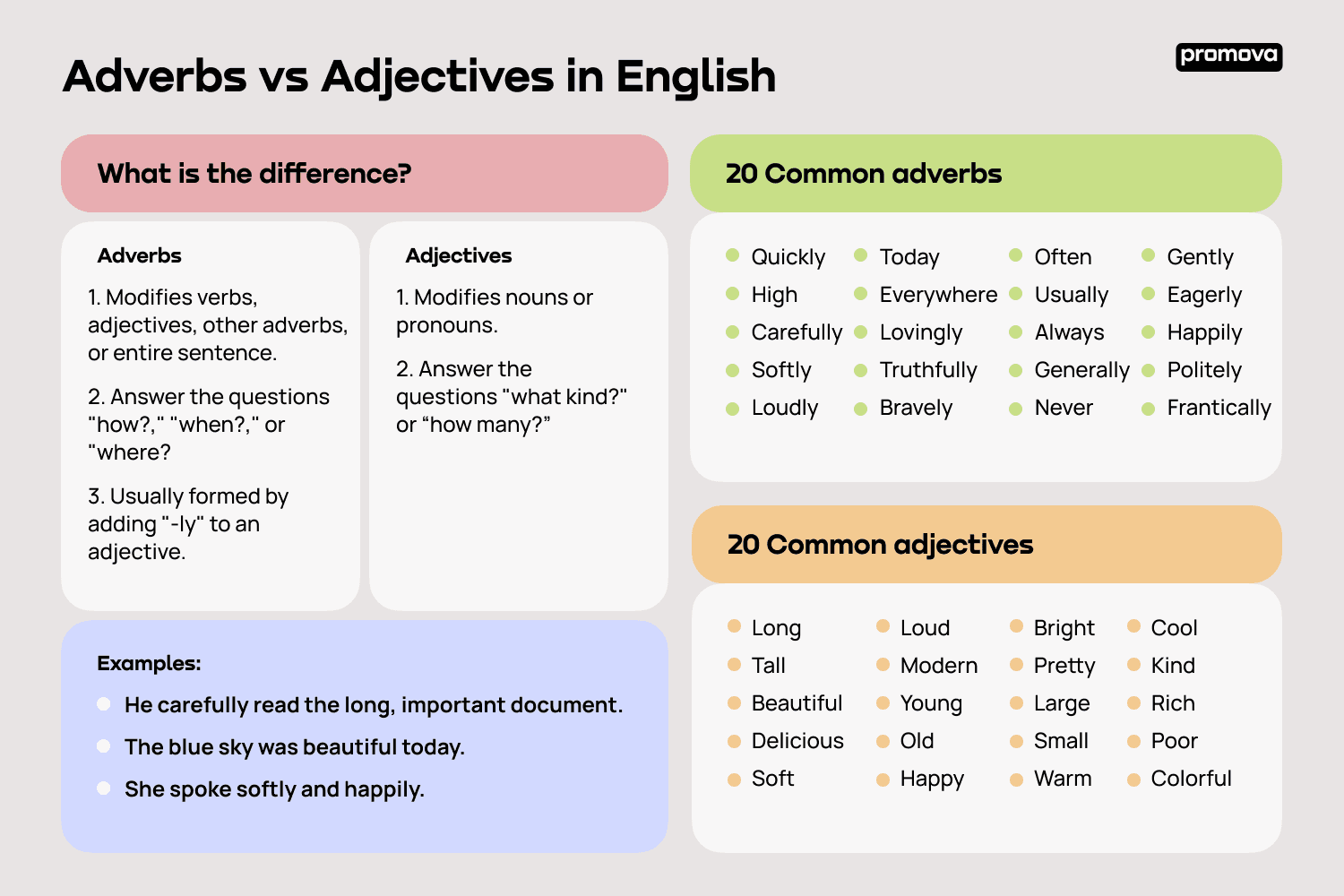Adverbs vs Adjectives in English
Contents
Adverbs and adjectives are among the most common parts of speech in the English language. They both modify nouns and verbs, but they do so in different ways.
To become an expert in English grammar, it’s important to understand the subtle differences between adverbs and adjectives and how to use them correctly. In this reference, we’ll cover the basics of adverbs and adjectives and provide plenty of examples to help you master the difference between these two parts of speech.
Adverb vs Adjective
Adverbs and adjectives are closely related, but they have some distinct differences. An adverb is a word or an entire phrase that modifies or describes a verb, an adjective, or another adverb. Adverbs typically answer the questions "how?," "when?," or "where?".
On the other hand, an adjective is a word or an entire phrase that modifies or describes a noun or pronoun. Adjectives typically answer the questions "what kind?," or “how many.”
For example, in the sentence “He ran quickly,” the adverb “quickly” modifies the verb “ran.” In the sentence “She likes red apples,” the adjective “red” modifies the noun “apples.”
it's easy to see why adverbs and adjectives are often confused. The difference between them is subtle for non-native speakers, however there's an easy distinction. You can easily know if a word is an adjective or an adverb by looking at the context. If it's modifying a verb, it's an adverb; if it's modifying a noun or pronoun, it's an adjective.
What is the difference between an adverb and an adjective?
The primary difference between an adverb and an adjective is that an adverb modifies verbs, adjectives, or other adverbs, while an adjective modifies nouns or pronouns. An adverb can also modify an entire sentence, while an adjective cannot.
Another way to think about the difference between adverbs and adjectives is to consider the type of questions they answer. As noted above, adverbs answer the questions "how?," "when?," or "where?," while adjectives answer the questions "what kind?" or “how many?”
Lastly, adverbs are usually formed by adding "-ly" to an adjective (e.g. quickly, happily). So if you're ever in doubt, you can always look for the "-ly" to determine if a word is an adverb.
Adjective and adverb examples
To understand the difference between an adverb and an adjective, let’s look at some examples.
Adverbs:
- She quickly ran to the store.
- The cat jumped high.
- He reads carefully.
- She speaks softly.
In these sentences, the adverbs help us understand how she ran (quickly), how the cat jumped (high), how he reads (carefully), and how she speaks (softly).
Adjectives:
- The red apple was delicious.
- She has long hair.
- He has a tall frame.
- The blue sky was beautiful.
In these sentences, the adjectives help us understand what kind of apple it was (red), what kind of hair she has (long), what kind of frame he has (tall), and what color the sky was (blue).
7
Simple list of adverbs and adjectives
20 Common Adverbs:
- Quickly
- High
- Carefully
- Softly
- Loudly
- Today
- Everywhere
- Lovingly
- Truthfully
- Bravely
- Often
- Usually
- Always
- Generally
- Never
- Gently
- Eagerly
- Happily
- Frantically
- Politely
20 Common Adjectives:
- Long
- Tall
- Beautiful
- Delicious
- Soft
- Loud
- Modern
- Young
- Old
- Happy
- Bright
- Pretty
- Large
- Small
- Warm
- Cool
- Kind
- Rich
- Poor
- Colorful
Sentences with adjectives and adverbs
Now let’s look at some sentences that use both adverbs and adjectives.
- She quickly ran to the store to buy a delicious red apple.
- He carefully read the long, important document.
- The blue sky was beautiful today.
- She spoke softly and happily.
As you can see, the adverbs (quickly, carefully, today, softly, and happily) help to describe how something was done or when it was done. The adjectives (delicious, red, long, important, blue, beautiful) help to describe what something is like.

Summary
The primary difference between an adverb and an adjective is that an adverb modifies verbs, adjectives, or other adverbs, while an adjective modifies nouns or pronouns.
Adverbs typically answer the questions how, when, or where, while adjectives answer the questions what kind or how many. Being able to correctly identify what's the difference between an adjective and an adverb is helps us avoid confusion and sound far more natural in our language.
Comments